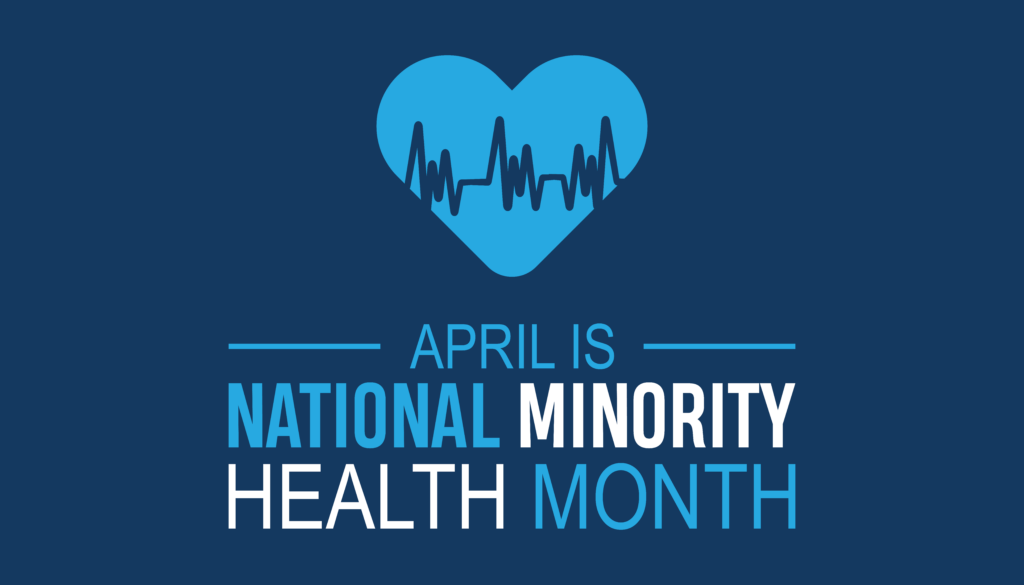Advancing Health Equity: National Minority Health Month and the Challenges Faced by Minority Communities
 When it comes to public health, it is important to acknowledge the significance of addressing health disparities and advocating for health equity. National Minority Health Month, observed annually in April, serves as a crucial platform for raising awareness about the unique health challenges faced by minority communities.
When it comes to public health, it is important to acknowledge the significance of addressing health disparities and advocating for health equity. National Minority Health Month, observed annually in April, serves as a crucial platform for raising awareness about the unique health challenges faced by minority communities.
The health observance was established to underscore the need for health equity among minority populations. This month-long initiative focuses on raising awareness about the disproportionate health disparities experienced by racial and ethnic minorities. It serves as a call to action for communities, healthcare providers, and policymakers to address these disparities and work towards achieving health equity for all.
Here are a few areas of focus for the month:
Access to Healthcare:
One of the primary challenges faced by minority communities is limited access to quality healthcare. Barriers such as lack of insurance, transportation, and cultural competence in healthcare settings often prevent individuals from seeking timely and appropriate medical care.
As a Federally Qualified Health Center, Brevard Health Alliance (BHA) offers a wide range of primary healthcare services to individuals and families, regardless of their ability to pay.
BHA aims to improve the health status of medically underserved populations in Brevard County by providing comprehensive and compassionate care. We operate multiple clinics across Brevard County, and travel to areas of need with our mobile unit, to meet patients where they are.
Socioeconomic Factors:
Minority populations often grapple with socioeconomic factors that impact their health outcomes. Higher rates of poverty, limited educational opportunities, and unstable housing contribute to disparities in health status and access to preventive care.
BHA offers a sliding fee scale based on income and family size, allowing individuals and families with limited financial resources to receive care at a reduced cost. Additionally, BHA participates in government-funded programs such as Medicaid and Medicare, as well as helping patients apply for insurance coverage through the Health Insurance Marketplace.
“The sliding scale fee is a nominal cost that allows most patients access to primary care,” explains BHA Chief Medical Officer, Dr. Ted Schuck, DO. “Additionally, preventative tests are often supported such as annual labs, Pap smears, EKGs, and mammograms. These tests and office visits allow providers to catch diagnoses that a patient may have otherwise neglected due to financial constraints.”
Cultural and Linguistic Barriers:
Cultural and linguistic differences can create significant barriers to effective healthcare communication. When healthcare providers do not understand the cultural nuances of their patients or fail to communicate in their preferred language, it can result in misunderstandings, misdiagnoses, and ultimately poorer health outcomes.
BHA provides interpretation services in multiple languages, both in-person and over the phone, to ensure proper communication between healthcare providers and patients who are not proficient in English.
Implicit Bias in Healthcare:
Implicit biases, whether conscious or unconscious, can affect healthcare providers’ decision-making processes and patient interactions. Minority individuals may face discrimination, stereotype-driven assumptions, and suboptimal care due to these biases, leading to distrust in the healthcare system.
“BHA strives to best represent the local community served by each clinic through inclusion of providers and staff that embody their community,” says Schuck. “Diversity is intentional. Numerous studies have suggested that patients better connect to providers and staff they can assimilate to.”
Prevalence of Chronic Conditions:
According to the Centers for Disease Control and Prevention (CDC), racial and ethnic minority groups in the United States face significant disparities in health outcomes compared to the general population. Certain health conditions, such as diabetes, hypertension, and obesity, disproportionately affect minority communities.
These following chronic conditions are often linked to lifestyle factors, genetics, and the social determinants of health that minorities are more likely to face.
Cardiovascular Disease (CVD)
According to the CDC, Black adults are disproportionately affected by cardiovascular disease (CVD) and related mortality. They experience higher rates of hypertension, heart disease, and stroke compared to White adults.
Black Maternal Mortality Rates
Black women in the United States are disproportionately affected by maternal mortality. According to the CDC, black women are three to four times more likely to die from pregnancy-related complications than white women.
Hispanic women also face disparities in maternal health outcomes. The CDC reports that Hispanic women experience maternal mortality rates higher than those of non-Hispanic white women, although lower than those of black women.
Socioeconomic factors also contribute to maternal mortality disparities. Women from lower socioeconomic backgrounds, regardless of race or ethnicity, are more likely to experience adverse maternal health outcomes. According to the American College of Obstetricians and Gynecologists, access to quality prenatal care, education, and economic resources plays a significant role in these disparities.
Food Access Gaps
According to the CDC, Minority communities, particularly Black and Hispanic populations, often have limited access to healthy food options and are more likely to reside in areas with higher concentrations of fast-food restaurants and fewer grocery stores offering fresh produce.
BHA social workers are engaged in connecting patients in need with food resources. The health center also works with local organizations such as the Children’s Hunger Project, to assist with ensuring children in Brevard have nutritious food packages on the weekends.
“BHA providers and staff understand that a patient’s medical conditions are just a piece of their overall health. We integrate medical, behavioral, dental, and social factors when caring for patients. When a patient’s social needs are not being met (i.e. scarcity of healthy food), their medical well-being suffers. All of these factors are taken into consideration.”
Colon Cancer Disparities
Black individuals, according to the American Cancer Society, have a higher rate of colon cancer and are more likely to die from it compared to other racial/ethnic groups in the United States.
Initiatives to Promote Health Equity:
 Brevard Health Alliance is committed to advancing health equity through various initiatives aimed at empowering minority communities and fostering inclusive healthcare practices.
Brevard Health Alliance is committed to advancing health equity through various initiatives aimed at empowering minority communities and fostering inclusive healthcare practices.
Community Outreach and Education:
Brevard Health Alliance actively engages in community outreach and education programs to empower minority communities with knowledge about preventive healthcare measures, available resources, and the importance of regular check-ups.
Cultural Competence Training:
Healthcare providers at Brevard Health Alliance undergo cultural competence training to ensure that they can effectively communicate with and understand the diverse backgrounds of their patients. This fosters a more inclusive and patient-centered approach to care.
Collaboration with Community Partners:
Brevard Health Alliance collaborates with local community organizations and leaders to bridge the gap between healthcare providers and minority populations. Through partnerships with incredible organizations including the Florida Department of Health, Brevard Public Schools, and Daily Bread, BHA is working to address the unique needs of different communities and provide tailored healthcare solutions.
“There are multiple touch points for patients within the county with great organizations that may be able support their challenges. It is only in the best interest of BHA and our patients to provide them with all resources available,” says Schuck. “Additionally, these organizations understand the resources we have at our disposal.”
As we observe National Minority Health Month thus April, it is essential to recognize the challenges faced by minority communities, especially when it comes to equitable healthcare.
“Our mission is, ‘to improve the health status of Brevard County by providing a medical home where all patients receive high-quality care in a timely manner. We commit to ensuring every patient we serve is heard, encouraged, and respected.’”
By raising awareness, implementing community-focused initiatives, and advocating for policy changes, we can collectively work towards a future where health disparities are minimized, and everyone, regardless of their background, has the opportunity to attain their highest level of health.

Dr. Theodore Schuck is a Doctor of Osteopathy, and the Chief Medical Officer for Brevard Health Alliance. Dr. Schuck leads the way in clinical care for our patients and ensuring every patient we serve is heard, encouraged, and respected.


































































































































